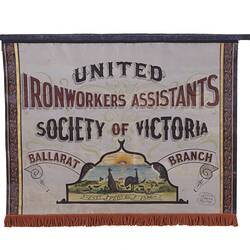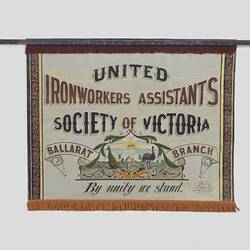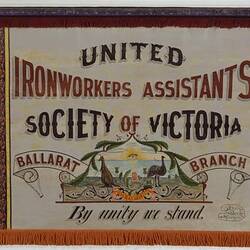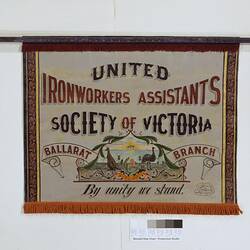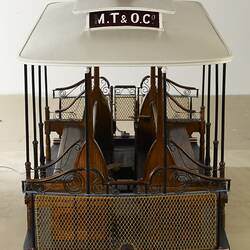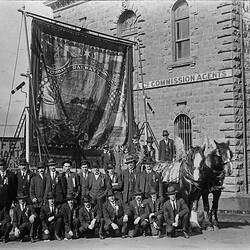Summary
Canvas banner painted in 1890 for the United Ironworkers' Assistants Society of Victoria, Ballarat Branch. Formed in 1886, the Ballarat Branch of the Ironworkers commissioned Kift & Smith, a local firm of commercial painters and decorators, to make the banner for the annual Eight Hour Day procession. It was first paraded through Ballarat's streets in 1890, as recorded in the Ballarat Star: 'The banner of the Ironworkers Assistants' Union...made its first appearance in public.'
It was included on the Victorian Heritage Register 8 December 2005, Heritage Register Number H2086.
The Eight Hour Day march commemorated a successful protest march held on April 21, 1856 by Victorian stonemasons and other members of the building trades. The protest resulted in an agreement by the Victorian Government to ensure all workers on public sites had an eight hour working day. In recognition of the significance of this achievement, April 21 was made a public holiday in 1879 and commemorative marches were held each year from 1879 until 1951. The Eight Hour Day holiday was renamed Labour Day in 1934. In 1955 the Labour Day march and celebrations were replaced by Moomba celebrations.
Physical Description
Fine linen tabby weave canvas folded at left hand side, with selvage edges top and bottom, and blue cotton blanket stitch seam on right hand side. Bottom edge is whip stitched using natural cotton/linen thread. Top edge is not sewn and secured to hanging pole with iron tacks through both canvases. Possible blue ground layer overall (oil media). Oil media and gilt decorative layer. No varnish layer evident. Crimson wool fibre bullion fringe, attached along top edge of recto using iron tacks through canvas into pole. Red wool fibre fringe attached along bottom edge on both sides using red wool hand running stitch. Timber 65 mm circular profile pole with white gesso layer and blue oil paint decorative finish. Iron collars at both ends and iron screw thread rods protruding from each end to support timber turned finials. Side A - Lettering dominates the banner. Kangaroo and Emu emblem set within floral garland of British emblems (thistle, rose and shamrock) with centralised 'all seeing' eye positioned lower half. Painted 170 mm wide vertical edge decorative borders. Signed lower right hand corner. Side B - Lettering dominates the banner. Kangaroo and Emu emblem set within floral garland of British emblems (thistle, rose and shamrock) with centralised 'all seeing' eye positioned lower half. Painted 170mm wide vertical edge decorative borders. Signed lower right hand corner.
More Information
-
Collection Names
-
Collecting Areas
-
Acquisition Information
Loan & Subsequent Donation from Victorian Branch, Australian Workers' Union (AWU), University of Melbourne Archives (The), Dec 1998
-
Artist
Kift & Smith, Sturt Street, Ballarat, Victoria, Australia, 1890
-
Commissioned By
Ballarat, United Ironworkers' Assistants Society of Victoria, Ballarat, Victoria, Australia, 1890
-
Inscriptions
Side A: UNITED/ IRONWORKERS ASSISTANTS/ SOCIETY OF VICTORIA/ BALLARAT BRANCH/ EST FEB 1st 1866/ By unity we stand./ Kift &/ Smith/ Writers Side B: UNITED/ IRONWORKERS ASSISTANTS/ SOCIETY OF VICTORIA/ BALLARAT BRANCH/ ESTD. FEB 1st 1886/ Kift &/ Smith/ Writers
-
Classification
-
Category
-
Discipline
-
Type of item
-
Overall Dimensions
2035 mm (Length), 2450 mm (Width)
Metal bracket: 2490mm L X 110mm W. Banner Pole: 4 metres long.
-
Overall Dimensions
2430 mm (Width), 2035 mm (Height)
Measurement From Conservation. Height includes 215 mm of fringe and band (120 mm on top and 95 mm on bottom).
-
Keywords
8 Hours Day Movement, Trade Unions, 8 Hours Day Celebrations, Workers, Working Life, Workers Rights, Making History - Eight Hour Day

